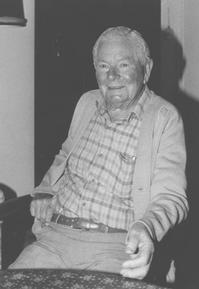


Memories of the Bureau of Meteorology
Preface
Memories of the Bureau of Meteorology 1929–1946 by Allan Cornish
Foreword
Chapter 1: My Early Days in the Bureau
Chapter 2: Some New Vistas
Chapter 3: The RAAF Measures Upper Air Temperatures
Chapter 4: The Bureau Begins to Grow
Chapter 5: My Voyage in Discovery II
Chapter 6: The Birth of the Instrument Section
Chapter 7: Darwin Days
Chapter 8: I Leave the Bureau
History of Major Meteorological Installation in Australia from 1945 to 1981 by Reg Stout
Four Years in the RAAF Meteorological Service by Keith Swan
The Bureau of Meteorology in Papua New Guinea in the 1950s by Col Glendinning
Index
Search
Help
Contact us

Chapter 1: My Early Days in the Bureau
I was one of three Meteorological Assistants who joined the Bureau in 1929. Our appointments appeared in the same Gazette dated 20 December 1929. We were listed in alphabetical order and Cornish became the senior of the three people. The others were Alf Rose and Keith Rawson.
Rawson later sat for and topped the Clerical Examination and went straight to the office of the Public Service Inspector in the Department of Home Affairs.
At first, Met Assistants (who were in the Third Division) were trained to prepare the bulletin (a list of the observations made throughout Victoria on that day), to make the Melbourne observations and to undertake pilot balloon flights. The pilot balloon flights were made using 10 gram balloons and theodolites located on a platform built on the roof of the old Frosterley building.
The job began by making the Melbourne surface observations and despatching them by telegram. It was then necessary to prepare for the production of the bulletin by getting all the duplicating ink ready. It was a filthy job. The Met Assistant then telephoned the Bureau's Jack Emmett who was located at the Postmaster-General's Central Telegraph Office in the city. Jack decoded and called out over the phone the telegrams received from outstations. These observations, received by phone, were written directly onto the bulletin.
The telegrams consisted of a string of words, each word representing a specific pressure, temperature, humidity, wind speed and direction, etc, etc. For instance the word Tragic indicated a temperature of 60 deg Fahrenheit. The words in the weather code were shortened later on. The word sex was the code word for a hot wind.
When rain was general throughout the State the bulletin took longer and was not finished until about half past one. In addition to the State bulletin an interstate bulletin was prepared. Joe Radic plotted the observations on a synoptic chart. Joe sat beside the man writing the bulletin and when he had finished plotting the observations Ackeroyd analysed the plotted chart.
People in Bright Sparcs - Cornish, Allan William
 |
Bureau of Meteorology |  |
© Online Edition Australian Science and Technology Heritage Centre and Bureau of Meteorology 2001
Published by Australian Science and Technology Heritage Centre, using the Web Academic Resource Publisher
http://www.austehc.unimelb.edu.au/fam/0499.html